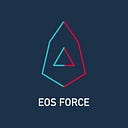2018, what a year for blockchain.
We saw the demise of the ICO hype and the inflated value of unsustainable cryptoeconomic designs and low-grade blockchain projects — proving the old saying
“This too shall pass.”
We also saw the rise of blockchains that responded to the urgent market needs of scalable, high-TPS networks. The market shifted from imagining on whitepapers to coding with developers— marking the next step of blockchain
“We need real application use cases.”
Otherwise it’s not just the matter of death or victory for ***coin maximalists or this fork that fork, but the death of the industry. Word on the street was “ten years in, nobody has come up with a use for blockchain.” Where was the future of blockchain?
Following the rise of CryptoKitties, a swarm of blockchain-based games gave the industry a glimpse into the mass adoption future. The rise of game dApps on EOSIO kept the technology afloat and the community confident. However,
“The future of blockchain will be not gambling dApps.”
It is a reality check. We need massive, enterprise-scale application for blockchain. The application must come with support from the mainstream the likes of e-commerce, social media, finance, etc.
Following EOSIO, a group of application-backed sister blockchains built on the same scalable software came into existence, offering a look into a blockchain future. Worbli in finance. ONO in social platform. This kind of one-chain-one-application model paints us a picture in which every single application in the world is made decentralized on its own custom blockchain.
Unlike hundreds of game dApps being built on one single EOS Blockchain, the one single chain application has the full network TPS at its disposal, no need to worry about congestion and scalability issues. However, they maintain the decentralized nature, offering an edge to their centralized Internet 2.0 counterparts.
“Future of the Internet: each application has its own blockchain.”
In Internet 2.0, software launch has already been made easy enough for developers to complete one singlehandedly straight out of a garage. The “developer-app store-user” process is streamlined. If we want mass adoption for blockchain, we need to lower the skill threshold for developers. If to develop a decentralized application, one needs a whole company of developers and an ICO for funding support, the blockchain future is never going to happen. In other words,
“DApp developers need to easily launch a blockchain for their own application easily and at a low cost.”
When we have lowered the cost of development and blockchain expertise, migration of commercial scale applications to blockchain is not hard to see, and new applications built on blockchain will come in phenomenal numbers.
In this large network of blockchains, each with their custom design, we would want an ability to exchange information and value like we do on an Apple App Store and in a Google database. This is the thinking behind interblockchain communications (or IBC). But we don’t want this interconnection ability to be centralized as in Apple’s App Store or Google’s database. We want IBC decentralized just like any other blockchain. We want that
“Blockchains are able to communicate with other blockchains through a decentralized multichain network.”
Really, when we are talking about building all this infrastructure of blockchain in the year of 2018, this should be what we talk about.
No single blockchain is able to support a scaled application singlehanded.
No single blockchain is able to achieve tranfering value without a multichain network.
More importantly, nobody is going to use blockchain if it’s expensive and inaccessible to regular developers.
When we talk about building a blockchain future, we must take all these harsh socioeconomic realities and technical designs into account. 2018 gave a great start, but left much to be desired.
Year 2019, EOSForce makes the following promise: we will give to the blockchain industry a prize to the mainstream: on EOSForce, developers will be able to custom launch their own blockchain for application with “one-click”.
Year 2019, EOSForce will enable interblockchain communications with major chains like Ethereum, Bitcoin and others, as well as other blockchains built through EOSForce.
June 2018, we launched EOSForce blockchain. End of 2018, we announced our BCH development plan. Entering 2019, we share our roadmap with you for the year ahead:
2019 Q2 will see the launch of EOSIO relaychain and multichain asset trading platform.
2019 Q3 will see the relaychain and the trading platform support BTC and ETH heterogeneous blockchain interoperability.
2019 Q4, other public blockchains can freely interact with EOSForce.
Mass Adoption for diverse cryptoeconomics and blockchain
That is the EOSForce promise.
2019, let’s go.
Contact EOSForce
Twitter | English Telegram | Reddit | Github |Korean Telegram
EOSForce blockchain explorer: https://explorer.eosforce.io/#/en
Wallets
https://github.com/eosforce/wallet-desktop
- EOSC token is distributed in accordance with the EOS genesis mapping. You can activate your EOSForce genesis account here.
Scatter 10 has minor compatibility issues with EOSForce blockchain. Join the Telegram Channel here: https://t.me/Scatter. Visit the Scatter website at: https://get-scatter.com/
Exchanges
Bitforex | Akdex.io
